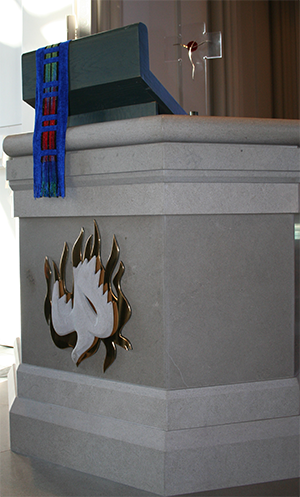
Overview
A thematic structure emphasizes logic, thought. The structure of the sermon arises from a central teaching that is logically presented to the hearers. In this case, the logical exposition of a central thought forms the progression of the sermon and the hearers will be able to follow the sermon because of the clear statement of the theme, especially at points of transition.
In writing this sermon, the preacher needs to be able to identify the theme statement for the sermon, break that theme into parts (rhetorical units), and then arrange those parts in a logical order. The logical progression of the theme forms the major transitions of the sermon.
In thematic sermons, four matters are important to consider as the preacher develops each of the points of the sermon.
First, the preacher usually wants each point to be related to the text and to the lives of the hearers. This way, the sermon mirrors how teachings of the faith arise from God’s word and shape the lives of his people.
Second, the law and gospel proclamation of these sermons tends to be incorporated in the development of specific points. Thus, a thematic sermon could proclaim the gospel three times (within three of the four points being made in the sermon) rather than having a major law/gospel progression at the middle of the sermon (as in the law/gospel structure).
Third, each point of the sermon does not need to be developed with logical explanation. Often, because the use of logic forms the progression of the sermon, preachers can feel that logic needs to be used in each section of development as well. To do this turns the sermon into a lecture. While the transitions of the sermon are based on logic, the development of each point may use whatever method best communicates the main idea to the hearers. For example, a sermon could use the logic of cause-effect to lead the hearers through four experiences of Christian prayer: God’s grace (cause) leads to the prayer of thanksgiving (first effect). While logic leads into the idea of the prayer of thanksgiving, the preacher may not want to use logic to develop what that prayer is. Instead, he uses narrative. He develops the prayer of thanksgiving for the hearers by telling a real-life story that shows what the prayer of thanksgiving looks like in action.
Fourth, the preacher will want to be aware of both inductive and deductive experiences in developing the points of the sermon. Some times, the preacher will develop an idea inductively, offering the hearers the story or the serial depiction and then concluding with a clear statement of the point of that portion of the sermon; other times, the preacher will develop an idea deductively, clearly stating the point first for the hearers and then offering the material that develops the idea for them. The variation of methods of development (story, explanation, image, character, dialog, etc.) and the variation of inductive and deductive development help maintain hearer interest in thematic preaching.
Listed below are traditional logical forms that have been used to establish thematic discourse structures.
